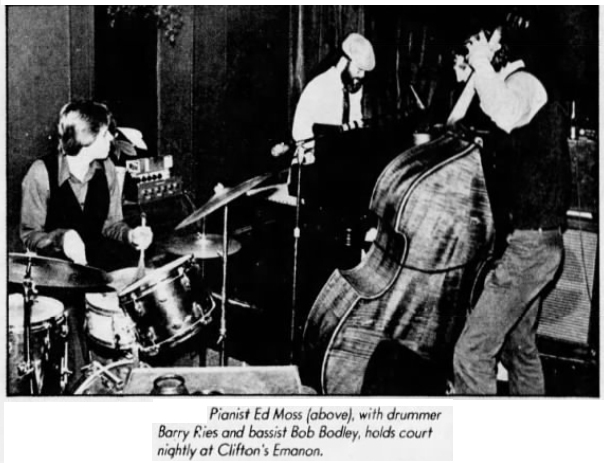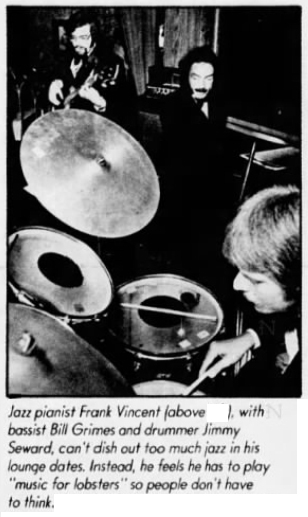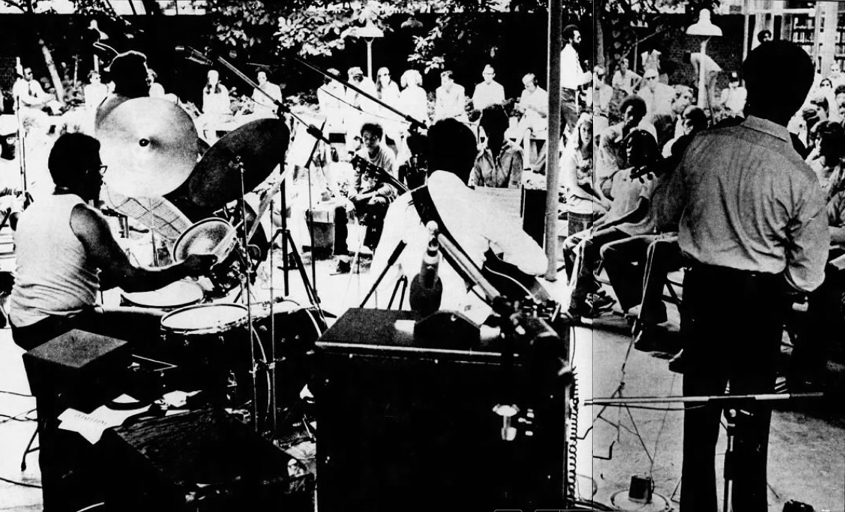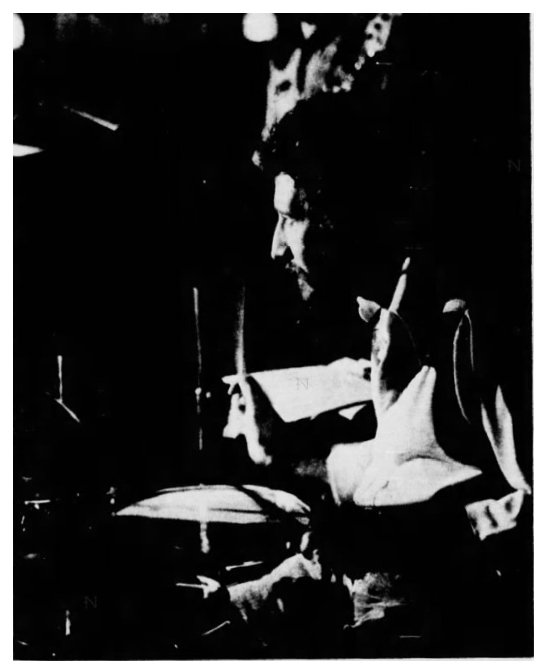It is hard to realize how many good jazz musicians there are in town. In addition to the well-known names like Felice, Vincent, Stolar, Moss and Popeye Maupin, there are scores of lesser known musicians who would love the freedom to play jazz in a club or motel without having to bend to the crowd, or, as some jazzmen might say, "sell-out."
Gordon Brisker is an example. Brisker was a saxophonist with Woody Herman's band in 1960-61. He's spent most of the last four months hiring the 18 musicians needed to fill the two nine-piece bands which worked during the summer at Kings Island. He would rather do club work, but notes that it doesn't seem like there is a club in town that can yank the jazz fans out of the comfort of their homes.
When not working or playing at Kings Island, Brisker joined Fred Lucht and Rudy Minitti's L&M Big Band for several free outdoor concert dates at county and city parks, one of which, at Winton Woods, drew more than 5000 people on a Friday evening.
The powerful L&M band duplicates many original Stan Kenton and Woody Herman big band arrangements and is formed from a pool of about 25 local musicians. According to Lucht, once a drummer in Les Elgart's band, the L&M band has been working about 10 times a year, mostly at private things like dances at hotels or country clubs.
As an example of what he and other musicians seeking regular jazz work must face, Lucht recalls the response the manager of a downtown hotel gave when he suggested that his hotel book the L&M band for weekend dance work: "He said, 'No one else in town is doing it, why should I?'"
Another almost unknown local jazzman is Sam Jackson. For awhile it looked as if he were to become the house pianist at the Celestial Restaurant on Mt. Adams. He and another jazz pianist, Judy Weech, shared Celestial, each taking three nights and playing a mixture of popular tunes and jazz standards, but a male-female duo recently replaced them. Both were supported by Allen Thompson on bass and Levi Hooks on drums. All are Jazz Lives alumni.
Jackson, who works at the Post Office during the day, would prefer regular club work. So would female jazz pianist Mary Johnson. The 27-year-old Conservatory of Music product worked most of the summer in the orchestra pit at Kings Island in one of Gordon Brisker's bands.
She, Jimmy McGary, Phillip Paul, and Bob Bodley did the May 1974, library concert as the Mary Johnson Quartet. Mary, who also sings, specializing in Carmen McCrae and Nancy Wilson standards, has worked many local clubs, including the Viking and Soho.
She, too, avoids the jazz musician label. "You don't get hired if you say you are a jazz musician. Most club managers think only commercial music will sell."
Probably, however, commercial or top-40 music is the only type that will sell these days. Lou Lausche, vice president of the Cincinnati Musicians' Association and a lawyer who keeps his hand in the jazz business by bass playing at parties, weddings and at Beverly Hills, thinks so.
“People just don't buy jazz today”, Lausche says. Club patrons either want to dance or to be entertained by something like husband-wife duos. Most motels and lounges in the area have live musical entertainment, he notes, but not jazz. It's top-40 bands and traveling rock bands.
Regardless of how tough it is to earn a living playing jazz, there are many musicians scrambling around Cincinnati trying to do it. The scene is volatile. Jazz groups form, break up and re-form. Jazz is heard here, then and there for a few weeks. The better musicians move out of the Cincinnati market to the regional circuits, such as jazz guitarist Wilbert Longmire, or move to New York, as David Matthews did. Others seek local work whenever possible.
Cal Collins, for one, has been picking jazz guitar at Whitey's on Colerain Avenue every Monday night for about five years. He and his "magic guitar" have become the nucleus of a Monday night "jazz workshop" where local jazzmen come to sit in and, as Collins says, "play jazz as they are not able to at their regular gigs."
Collins, typical of local jazz musicians, is always playing somewhere. Whether backing a national jazz name like Jeremy Steig at Gilly's in Dayton, or at Skipper's on Reading Road, Collins never stops playing jazz. Because his jazz-brothers do likewise, jazz stays alive in Cincinnati.
White-bearded Irish jazz saxophonist Jimmy McGary has played everywhere from Dilly's in Mt. Adams during the early '70s to the library with Mary Johnson's group. Daylight finds McGary working for the city. He plays jazz wherever he can at night.
An unlikely showcase for McGary's jazz sax sound was the Newport Travel Lodge's Gladiator Restaurant, where he and organist Dick Monroe labored as a duo on Friday and Saturday nights during August. While there, McGary made a statement which provides a clue to why jazz continues to be heard in Cincinnati and elsewhere, in spite of all the factors working against it.
At 2:20 a.m. on a Saturday morning the Gladiator is one of the few non-chili meals in town. While about 100 late night breakfast-gulping former revelers talked and ate at constant decibel level of 65, McGary and Monroe might as well have been playing to an empty room. Only those sitting at the small organ-bar two feet from the musicians could hear the music above the din.
When McGary closed "Green Dolphin Street," he was told, "Jimmy, no one was listening." He said, "I don't care, man, I was."
THE ENQUIRER MAGAZINE, SUNDAY, OCTOBER 26, 1975
by Bill Steigerwald







